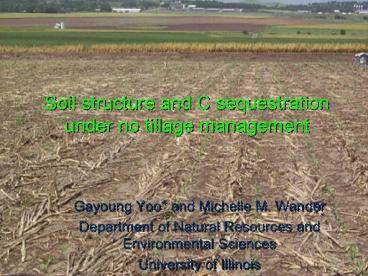Soil%20structure%20and%20C%20sequestration%20under%20no%20tillage%20management - PowerPoint PPT Presentation
Title:
Soil%20structure%20and%20C%20sequestration%20under%20no%20tillage%20management
Description:
... moisture, penetration resistance (PR), bulk density, and pore size distribution ... Bulk density ... SOC, clay, bulk density. ?fc. Data input. Functions ... – PowerPoint PPT presentation
Number of Views:112
Avg rating:3.0/5.0
Title: Soil%20structure%20and%20C%20sequestration%20under%20no%20tillage%20management
1
Soil structure and C sequestration under no
tillage management
- Gayoung Yoo and Michelle M. Wander
- Department of Natural Resources and Environmental
Sciences - University of Illinois
2
Variable no tillage influences by sites
- No tillage (NT) does not always increase C
sequestration.
- Soils are fine textured and poorly drained where
soil erosion is not a major factor or yield under
NT is reduced.
3
Background
No till
Conventional till
4
OUTPUT Soil erosion
INPUT Crop yield
SOC
microbes
Soil temp.
Soil water
SOIL STRUCTURE
5
Soil structure and SOM dynamic models
6
Site description
DeKalb Poorly drained Drummer silty clay loam
- Randomized complete block design
- 3 blocks
- Fixed effect site, till
- Random effect year, date
Monmouth Somewhat poorly drained Muscatine silt
loam
Treatments NT no tillage CT conventional
tillage
7
Objectives
- Investigate soil CO2 evolution patterns where
tillage practices have had varied influences on
SOC - Characterize site- and treatment-based
differences in soil physical factors that might
control C dynamics - Determine whether the soil structural quality
explains differences in SOC mineralization
8
Experimental methods
- Soil CO2 efflux measurement
- Li Cor 6400 (from 2000 to 2002)
- Environmental variables
- Soil temperature, soil moisture, penetration
resistance (PR), bulk density, and pore size
distribution - Statistical method
- ANOVA using PROC MIXED
- Non-linear regression using PROC NLIN (SAS
Institute)
9
Seasonal mean and specific C mineralization
10
Soil physical parameters
Penetration resistance
-- blows m-1--
91.57b
58.83a
70.47 b
59.97a
Effect Soil temp.
-----oC-------
Site DeKalb 18.85a
Monmouth 18.24a
Tillage NT 18.54a
CT 18.55a
Bulk density
---g cm-3---
1.32a
1.39b
1.41b
1.31a
Soil water
----------
25.03b
22.86a
24.30a
23.6a
Means, estimated with least square means,
within site or tillage not followed by the same
letter were significantly different at P lt 0.05.
11
Correlation coefficients
Soil temp Soil water PR BD Specific C min rates
Soil temp 1 0.03 -0.01 0.31 0.27
Soil water 1 -0.19 -0.30 -0.34
PR 1 0.30 - -0.06
BD 1 -0.16
Specific C min rates 1
12
Development of Q10 equation
- Basic Q10 model with soil temperature and
gravimetric water contents - Soil CO2 evolution
- (b
rSWC)Q10 (Ts-10)/10
Site Q10 b r R2
DeKalb 2.93 7.29 -0.18 0.63
Monmouth 2.93 7.29 -0.18 0.63
R2 (validation)
0.67
0.31
13
Pore size distribution
Total pore Total pore Macropore (gt 30 um) Macropore (gt 30 um) Micropore ( lt 30 um)
-------------------- ml g-1 soil --------------------- -------------------- ml g-1 soil --------------------- -------------------- ml g-1 soil --------------------- -------------------- ml g-1 soil --------------------- -------------------- ml g-1 soil ---------------------
DeKalb NT 0.444 a 0.104 a 0.104 a 0.334 a 0.334 a
DeKalb CT 0.442 a 0.109 a 0.109 a 0.340 a 0.340 a
Monmouth NT 0.339 a 0.068 a 0.068 a 0.271 a 0.271 a
Monmouth CT 0.379 b 0.086 b 0.086 b 0.294 a 0.294 a
Least square means within site not followed by
the same letter were significantly different at P
lt 0.05. Nissen et al. (unpublished data)
14
Least limiting water range(da Silva et al.,
1994 Topp et al., 1994)
0.5
Volumetric water content (cm3 cm-3)
0.2
1.1
1.5
Bulk density (g cm-3)
15
The calculation of LLWR Pedotransfer functions
(da Silva and Kay, 1997)
Limits Functions Data input
?fc SOC, clay, bulk density
?afp bulk density
?wp SOC, clay, bulk density
?sr SOC, clay, bulk density
wet
(1-Db/2.65) 0.1
dry
16
Mean LLWRs
Site Till ?fc ?fc ?afp
------------------------ cm3 cm-3 ------------------------------- ------------------------ cm3 cm-3 ------------------------------- ------------------------ cm3 cm-3 ------------------------------- ------------------------ cm3 cm-3 ------------------------------- ------------------------ cm3 cm-3 ------------------------------- ------------------------ cm3 cm-3 ------------------------------- ------------------------ cm3 cm-3 -------------------------------
DeKalb NT 0.541 c 0.379 b 0.379 b
DeKalb CT 0.560 d 0.412 a 0.412 a
Monmouth NT 0.427 b 0.360 a 0.360 a
Monmouth CT 0.411 a 0.384 a 0.384 a
?wp ?sr
0.347 c 0.346 c
0.353 c 0.322 b
LLWR
0.032 a
0.059 a
0.083 b
0.141 c
0.212 b 0.276 b
0.196 a 0.243 a
17
LLWR and SOC mineralization
18
Summary and Conclusions
- Inherently high protective capacity soils
- High clay content, high SOC, high macroporosity,
low BD, low LLWR - Not likely to be affected much by practices that
alter structure - Intermediate protective capacity soils
- Medium clay content, medium SOC, medium
macroporosity, high BD and LLWR - Physical properties can be altered to affect
biological activity and C sequestration by
tillage practice
19
Acknowledgement
- I would also like to thank Todd Nissen, Verónica
Rodríquez, Inigo Virto, and Iosu Garcia for their
invaluable assistance in the field. - Special thanks to Emily Marriott, Ariane Peralta,
and Carmen Ugarte for their helpful discussion,
editing, and advice.

